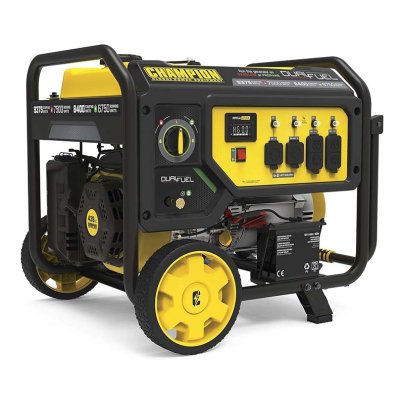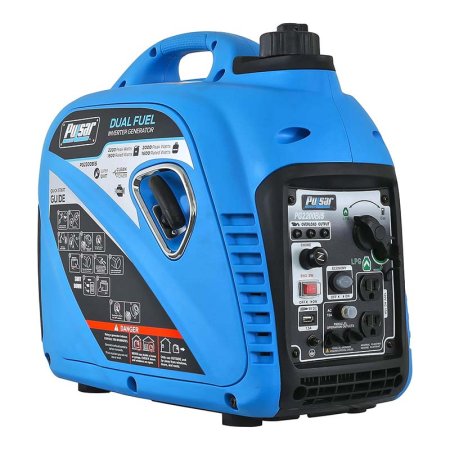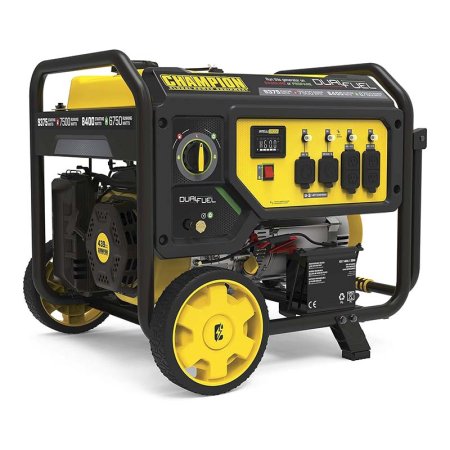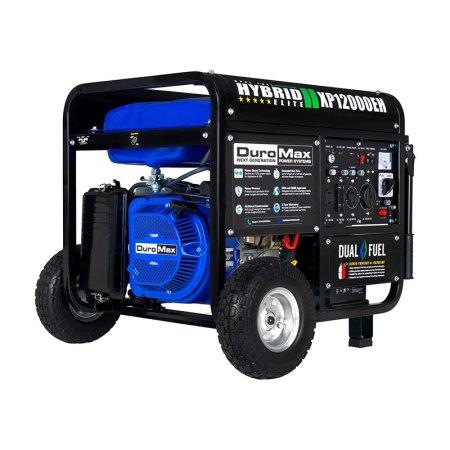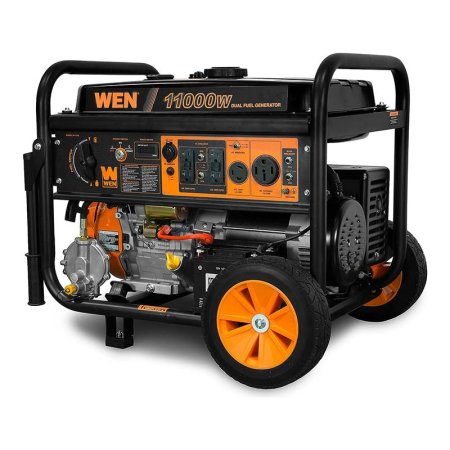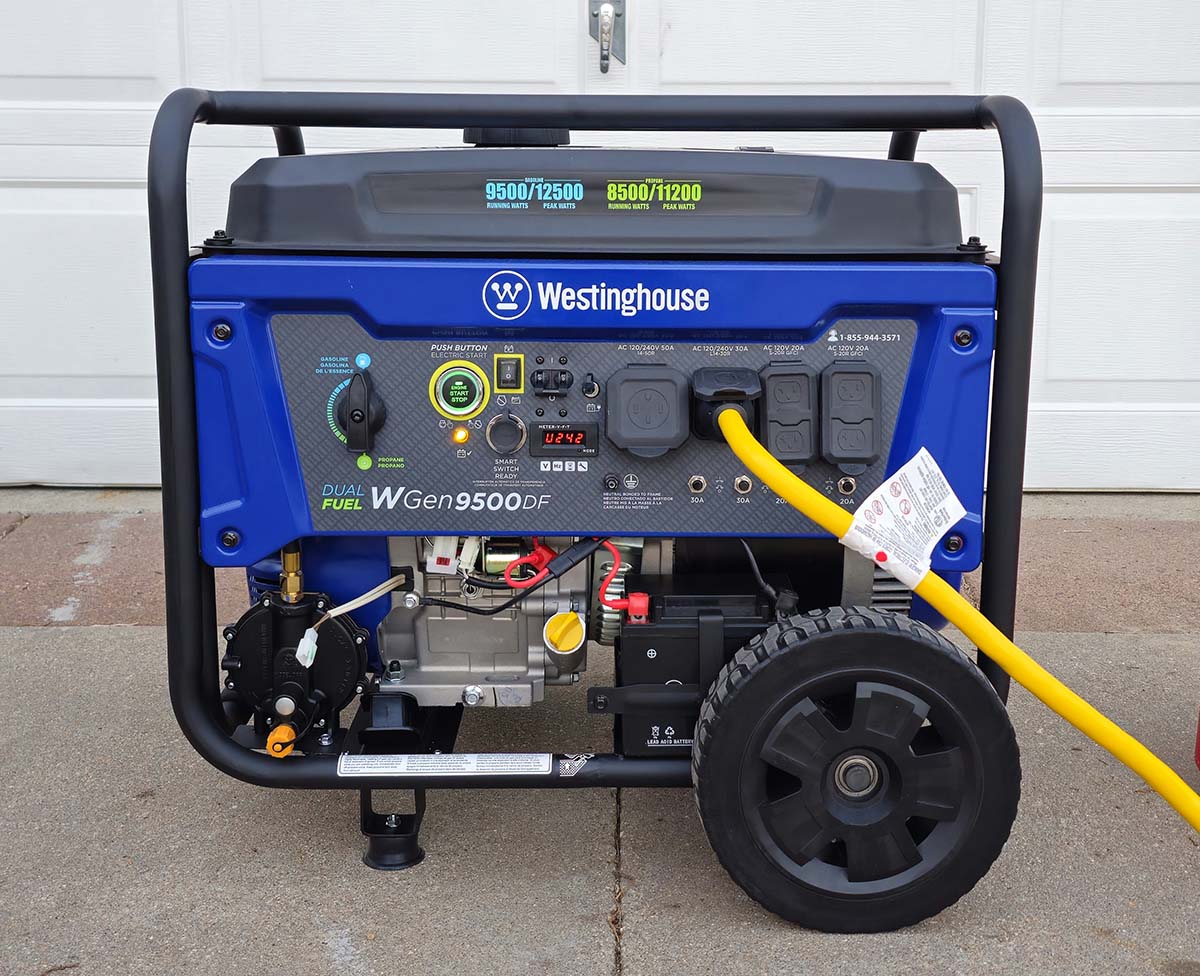
We may earn revenue from the products available on this page and participate in affiliate programs. Learn More ›
Like gasoline-only generators, dual-fuel models convert fuel into electricity, but since they run on either gas or propane, they are more versatile. Dual-fuel generators vary in quality, power output, and price. With growing concerns about over-taxed electrical grids and an increasing number of power outages, consumers are taking a good look at investing in home generators to provide electrical backup.
If you’re considering buying a dual-fuel generator but are unsure how much power you need or which features matter most, stick around. This guide explains how to choose a dual-fuel generator and details the seven best dual-fuel generators according to our hands-on tests.
- BEST OVERALL: Westinghouse WGen9500DF Dual-Fuel Generator
- BEST BANG FOR THE BUCK: Pulsar 2200-Watt Dual-Fuel Quiet Inverter Generator
- BEST MEDIUM-DUTY: Champion 7500-Watt Dual-Fuel Generator
- BEST HEAVY DUTY: DuroMax 12,000-Watt Dual-Fuel Portable Generator
- BEST EMERGENCY BACKUP: Wen DF11000T Dual-Fuel Electric Start Generator
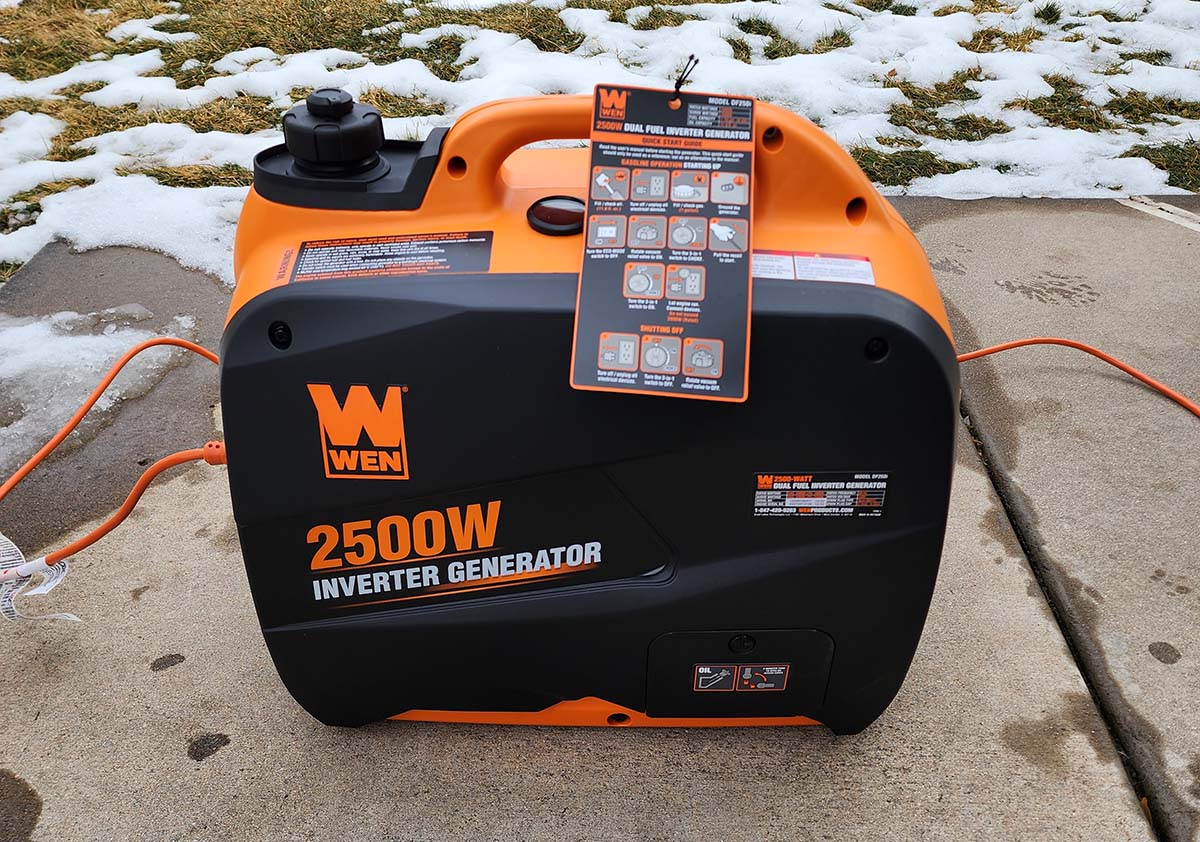
Before You Buy a Dual-Fuel Generator
Multifuel generators use gasoline or propane to provide electric power to your home, campground, or jobsite. But before buying a dual-fuel generator, consider whether it will meet your needs.
One key aspect of dual-fuel generators is you cannot run them indoors since they produce toxic fumes. Instead, you must set them up outside in a sheltered location and provide electrical power to appliances through an extension cord.
They are relatively heavy, weighing 100 to 200 pounds on average, and typically loud, sometimes exceeding the acceptable volumes allowed at RV parks. An inverter generator may be a better choice if you want a quiet generator. These generators have an enclosed body and supply power using a computer-controlled inverter instead of a noisier alternator.
However, if you need a decent amount of power, can see yourself regularly using more than one fuel type, and can handle a little extra weight and noise, a dual-fuel generator may be right for you.
How We Tested the Best Dual-Fuel Generators
Before selecting several high-quality models for hands-on testing, we researched more than 24 dual-fuel generators, looking for quality construction, ease of use, portability, and power output. We gave some consideration to top manufacturers but didn’t automatically eliminate smaller or niche manufacturers if their generators were highly rated and competitively priced.
For actual testing, we assembled the generators and ran them according to the manufacturer’s instructions. We allotted time to models requiring break-in periods so the machines’ internal components could lubricate and settle before powering appliances or tools. Our team of testers then plugged in power tools, appliances, and more while using an online wattage calculator to estimate a suitable electrical load.
We awarded points to each model using a rubric considering ease of use, noise, portability, power, and value. The better a generator performed a test, the more points it received. After testing, we averaged the points to determine top performers.
Our Top Picks
The following dual-fuel generators represent the best the market has to offer in various categories. Bob Vila team members thoroughly tested each one, and we detail their pros and cons below.
Best Overall
Westinghouse WGen9500DF Dual-Fuel Generator
Product Specs
- Wattage: Gasoline: 12,500 peak watts and 9,500 running watts; propane: 11,200 peak watts and 8,500 running watts
- Fuel: Gasoline or propane
- Outlets/ports: One 120/240 volt (V)-50 amp (A) outlet; one 120/240V-30A locking outlet; four 120V-20A ground-fault circuit interrupter (GFCI) outlets
- Weight: 211 pounds
Our Ratings: Ease of Use 4.5/5; Noise 4/5; Portability 4/5; Power 5/5; Value 4.5/5
What We Like
- Runs on either gasoline or propane, making it versatile in most situations
- Offers 3 ways to start: electric, remote, and recoil
- Robust 457 cubic centimeter (cc) 4-stroke engine delivers powerful electrical generation
- Features digital data display for real-time information about voltage, frequency, and runtime
What We Don’t Like
- Registered 89 decibels (dB) from 6 feet away, which is loud enough to annoy neighbors
- On the heavy side at 211 pounds, making it challenging to lift onto a truck bed
When it comes to choosing a good all-around generator, it’s tough to beat the Westinghouse WGen9500DF. This powerful generator runs on gasoline or propane, and selecting one or the other is as simple as flipping a switch. The WGen9500DF comes with a 6.6-gallon gasoline tank that will power the unit for up to 12 hours at a 25 percent load.
Actual runtime will depend on gasoline quality and how much power you’re drawing. On propane, it can run up to 7 hours on a 20-pound tank when drawing a 50 percent load. This model has a 120/240V-50A outlet, a 120/240V-30A locking outlet, and four 120V-20A GFCI outlets. At 9,500 running watts on gasoline, it’s powerful enough to run several tools simultaneously as well as an oven/range combo and clothes dryer separately.
The downsides? At 211 pounds, this is a heavy generator. It’s also loud, comparable to a motorcycle, which is enough to annoy neighbors yet reasonable for its output. If you’re looking for a quiet model, this might not be it. It is, however, a powerhouse of electrical output using whichever fuel is preferred.
Get the Westinghouse dual-fuel generator at Acme Tools.
Best Bang for the Buck
Pulsar 2200-Watt Dual-Fuel Quiet Inverter Generator
Product Specs
- Wattage: Gasoline: 2,200 peak watts and 1,800 running watts; propane: 2,000 peak watts and 1,600 running watts
- Fuel: Gasoline or propane
- Outlets/ports: Two 120V-15A AC outlets; 1 USB-A port
- Weight: 46.5 pounds
Our Ratings: Ease of Use 4/5; Noise 4/5; Portability 5/5; Power 4.5/5; Value 4.5/5
What We Like
- Light enough to move around without strain
- Easy to set up and get the engine running
- Ability to run on either propane or gasoline increases versatility
What We Don’t Like
- Access panel to change the oil was difficult to remove
- Changing the oil requires tipping the generator on its side, making it difficult to balance
We tested the Pulsar 2200-watt inverter generator and found it great for powering small tools and devices for up to 8 hours. With a 1.18-gallon gas fuel tank, it supplies 1,800 running watts and 2,200 peak watts. With propane, it delivers 1,600 running watts and 2,000 peak watts.
Setup was a bit difficult initially due to a side panel we had to manually force off to access the oil fill port. After that, though, getting the generator ready to start for the first time took only a couple of minutes. After giving the recoil start a couple of pulls, we found that the engine came to life quickly. Our test rig included a couple of heat guns and hair dryers running simultaneously on different high and low settings to vary the load.
We found the generator handled 1,800 watts as advertised, but noise levels seemed louder than expected yet still in a reasonable range for output. Overall, this generator is a great option for light-duty needs such as small DIY projects and powering a couple of household appliances during an outage.
Get the Pulsar dual-fuel generator at Amazon or Walmart.
Best Medium-Duty
Champion 7500-Watt Dual-Fuel Generator
Product Specs
- Wattage: Gasoline: 9,375 peak watts and 7,500 running watts; propane: 8,400 peak watts and 6,750 watts running
- Fuel: Gasoline or propane
- Outlets/ports: One 120/240V-30A locking outlet; one 120V-30A locking outlet; two 120V-20A duplex GFCI outlets
- Weight: 205 pounds
Our Ratings: Ease of Use 4.5/5; Noise 4/5; Portability 4/5; Power 5/5; Value 5/5
What We Like
- Runs for 10 hours per tank of gas or 5.5 hours per tank of propane at 50 percent load
- Numerous outlet options, including a 120/240V 30A for home backup
- Convenient electric ignition eliminates the need for recoil starting
- “Intelligauge” screen displays current power output and remaining runtime
What We Don’t Like
- Fuel consumption is higher per watt produced than the most efficient portable generators
- Despite its handle and wheels, it’s heavy and difficult to maneuver on unpaved ground
This Champion 7,500-watt dual-fuel generator is powerful enough to supply critical home circuits during an electrical outage or enough electricity for an off-grid DIY building site. Its startup is easy and intuitive, with a manual choke lever, an electrical start switch, and a recoil cord. During testing, it started on the first pull every time. Using gas, the Champion generator produces 9,375 starting and 7,500 running watts. A full 7.7-gallon tank will provide up to 10 hours of runtime at a 50 percent electrical load. On propane, it operates at 8,400 starting and 6,750 running watts, working for up to 5.5 hours on a 20-pound propane tank. It has two GFCI-protected duplex household outlets, a 120V-30A locking outlet, and a 120/240V-30A locking outlet.
We used the Champion at a building site to run a portable table saw, miter saw, pancake air compressor, router, and several battery chargers. The tools ran perfectly, and the generator didn’t lag. At home, we used it to run heavy-duty extension cords to individual appliances, easily powering our fridge, deep freezer, microwave, and either a space heater or window air conditioner.
The only things we didn’t love about this generator were its fuel-guzzling nature and how difficult it was to transport. Its hard plastic wheels worked fine on pavement, but this 205-pound machine was not easy to roll across soft ground or lift into and out of our truck. For those looking to power an RV, be aware its 74 dB noise level will be too much for most campgrounds.
Get the Champion 7,500-watt dual-fuel generator at Blain’s Farm & Fleet or Acme Tools.
Best Heavy-Duty
DuroMax 12,000-Watt Dual-Fuel Portable Generator
Product Specs
- Wattage: Gasoline: 12,000 peak watts and 9,500 running watts; propane: 11,400 peak watts and 9,025 running watts
- Fuel: Gasoline or propane
- Outlets/ports: One 120V/240V-50A outlet; one 120V/240V-30A locking outlet; one 120V-30A locking outlet; two 120V-20A GFCI outlets
- Weight: 224 pounds
Our Ratings: Ease of Use 3/5; Noise 4/5; Portability 5/5; Power 4.5/5; Value 4/5
What We Like
- Built for heavy-duty use; 9,000- to 12,000-watt power supply intended for large appliances
- Substantial fuel capacity provides ample runtime
- Built-in automatic shutdown kicks in when the generator runs low on oil
- Built-in carbon monoxide detector protects users from dangerous conditions
What We Don’t Like
- Lacks an hour meter or any way to track runtime, requiring users to keep track
- Does not come with dust covers to protect the multiple outlets when they’re not in use
When it comes to portable generators, 12,000 watts is near the top end in terms of power. The DuroMax dual-fuel portable generator is a monster that can power several tools and appliances simultaneously without throwing a breaker. We tested the DuroMax using gasoline and propane. It can run up to 8 hours on a full 8.3-gallon gas tank when pulling a 50 percent load and up to 7 hours on propane at 50 percent capacity. It also has an electric starter and a carbon monoxide (CO) sensor that automatically shuts the generator down if it senses hazardous levels of CO gas.
The DuroMax comes with several plug-in ports that extend its usefulness. It has a 120V-30A outlet, a 120/240V-30A outlet, two 120V-20A outlets (for standard power cords), and one 120/240V-50A outlet. We tested it by running our refrigerator, most of the entertainment devices in our home, and even a window AC that pulls a lot of juice. It didn’t lag at all.
Though we liked its power, the DuroMax missed the mark in a few areas. It doesn’t have drop-down generator covers to protect the outlets, and it only has two 120V standard outlets. Like other gas-powered generators, it’s also loud. Overall, though, we found this generator powerful and easy to use, particularly at this price point.
Get the DuroMax dual-fuel generator at Amazon, Tractor Supply Co., or Walmart.
Best Emergency Backup
Wen DF11000T Dual-Fuel Electric Start Generator
Product Specs
- Wattage: Gasoline: 11,000 peak watts and 8,300 running watts; propane: 9,500 peak watts and 7,500 running watts
- Fuel: Gasoline or propane
- Outlets/ports: One 120V/240V-50A outlet; one 120V-30A outlet; four 120V-20A GFCI outlets; one 12V DC outlet
- Weight: 214 pounds
Our Ratings: Ease of Use 4.5/5; Noise 4/5; Portability 4/5; Power 5/5; Value 5/5
What We Like
- Powerful output with up to 8,300 running watts on gas and up to 7,500 running watts on propane
- Easy to choose between using gasoline or propane—just flip a switch
- Electric start eliminates the struggle sometimes associated with pull-type recoil models
- Large 6.6-gallon gasoline tank offers a half-load runtime of up to 8.5 hours
- Multiple outlets for versatile usage: 4 standard household outlets plus a 30A and a 50A outlet
What We Don’t Like
- Heavy at 214 pounds, which reduces portability and being able to lift to a truck bed
- About as noisy as a gas lawn mower, so may disturb neighbors
For a propane generator ready to go at a moment’s notice, the Wen DF11000T is a great option. This powerful generator produces 11,000 peak watts (required to start a powerful tool like a saw) and 8,300 running watts when using gasoline. It provides slightly less power when operating on propane–9,500 peak watts and 7,500 running watts–but that’s still a lot of electrical power.
After its initial break-in period, we rotated through several tests, using the Wen to power a chest freezer, full-size fridge-freezer, laptop, tankless water heater, shop lights, table, chop saw, and circ saw. It didn’t show signs of being under any load except for a split-second surge when we started up one of the saws (saws are notorious for drawing a lot of power on start-up). We tested all the tools and items we could think of and had no problems.
Then, we did it all again while running the Wen on propane. We got the same excellent results, and switching from gasoline to propane only required flipping a switch. This model comes with an electric start and has a large 6.6-gallon tank that will keep it running for up to 8.5 hours at a 50 percent load. It features four standard household outlets, a 30A outlet, and a 50A outlet.
Like many fuel-powered generators, the Wen is pretty loud, about as noisy as a lawn mower. Yet, based on our tests, that’s a small price to pay for the hefty amount of power this durable generator provides.
Get the Wen DF11000T dual-fuel generator at Amazon, Walmart, or Wen.
Jump to Our Top Picks
What to Consider When Choosing a Dual-Fuel Generator
To find the best dual-fuel generator for your home, campground, or worksite, consider the factors listed below, including fuel efficiency, fuel tank capacity, power output, and control panel configuration.
Fuel Capacity
Dual-fuel generators have an isolated gasoline tank with a fuel capacity that ranges from as small as 2 gallons to more than 10 gallons. The larger the fuel tank on the generator, the longer the generator can provide gasoline-based power. But, as tank size increases, so does the size of the generator.
Fuel capacity does not affect how much propane you can use with your dual-fuel generator. Propane gas is stored under pressure in canisters, which attach to the generator with a hose and pressure regulator for direct fuel consumption.
Power Output
The power output on dual-fuel generators is measured in watts. Manufacturers’ specs include peak power output and running power output. Peak power output refers to the maximum number of watts the generator can provide at any one time. Running power output equals the average number of watts produced during use.
Dual-fuel generators generally produce a power output from 1,000 watts to over 12,000 watts, depending on their size. Gasoline produces a higher wattage than propane, so many manufacturers of dual-fuel technology break wattage into propane peak and running outputs and gasoline peak and running outputs.
For greater power output needs, users may need to consider a standby generator rather than a portable dual-fuel option.
Recoil Cord vs. Electric Start
You can start your dual-fuel generator with an electric start switch or a recoil cord.
- Electric start generators store extra electricity in an internal battery, which they then use to start automatically upon the press of a button or the flip of a switch. Electric starts are easier to use than recoil cords, but since they require stored electricity, they will not work without a charged internal battery.
- Recoil cords require quick and steady pulling to kick-start engines on generators, lawn mowers, chainsaws, and other fuel-powered tools. While they take effort and possibly more than a few pulls, they don’t rely on electricity. This allows you to start the generator anytime, even if it has been stored in the garage or shed for a few years.
Operating Noise Level
A generator’s operating noise level is measured in decibels. To understand the range of sound produced by a generator, consider these common sounds and their equivalent operating dB level:
- Refrigerator: 40 dB
- Hair dryer: 90 dB
- Motorcycle: 100 dB
Many dual-fuel generators produce 50 to 90 dB of noise, depending on fuel type (gasoline runs louder than propane) and power output. The most common range is between 65 dB and 75 dB, comparable to the sound of normal conversation.
The quietest dual-fuel generators combine dual-fuel technology and inverter technology to create a dual-fuel inverter generator.
Wheel Kit
Dual-fuel generators are typically large and heavy, with hoses or tanks that make them difficult to carry and move. Thus, some manufacturers include wheel kits for tilting the generator back and rolling it to the desired location.
You may also be able to purchase a wheel kit separately to add to your existing generator or replace an older wheel kit that doesn’t work well anymore. Either way, a wheel kit makes transporting a portable dual-fuel generator much easier.
Lift Hook Bar
Lift hook bars are handy on jobsites, allowing workers to attach the generator to a hook-and-pulley system and raise or lower it instead of carrying it up or down stairs or ladders. In industrial settings, this feature helps raise the generator onto a walkway or platform.
A lift hook bar will increase the generator’s weight (and likely the price), so don’t look for a generator with this feature unless you truly plan to use it.
Size and Weight
Most dual-fuel generators are between 22 inches long by 22 inches wide by 22 inches high and 35 inches long by 30 inches wide by 30 inches high. They typically weigh between 100 and 250 pounds.
If you plan to move the generator frequently, figure size and weight prominently into your decision. Make sure the model you choose fits into your vehicle so you can transport it as needed. Remember, however, that larger, heavier motors are also the most powerful. You’ll want to find the right balance of size, weight, and power to meet your needs.
The Advantages of Owning a Dual-Fuel Generator
Gasoline and propane each have their pros and cons as fuel options. Gasoline is easier to find, but propane costs less. Propane is a better fuel source in hot summer weather, while gas burns better in the cold. A dual-fuel generator lets you choose one or the other based on immediate circumstances.
Using both fuel sources, one after the other, greatly increases a generator’s runtime. Users can run to the gas station to refuel while the generator keeps providing power on propane.
Dual-fuel generators let users:
- Choose fuel type based on cost or availability.
- Switch between propane and gasoline depending on ambient temperature.
- Extend total runtime by using one fuel source and then the other.
FAQs
Before buying a dual-fuel generator, consider the answers to the following frequently asked questions.
Q. How does a dual-fuel generator work?
A dual-fuel generator operates like a single-fuel generator, except it can burn propane and gasoline to produce electrical energy. It converts mechanical energy produced by the burning fuels to force the movement of electrical charges and generate electricity.
Q. Can you run a dual-fuel generator on natural gas?
While some single-fuel generators can be adapted for use with natural gas, this isn’t the case with dual-fuel generators. Unless specially designed, dual-fuel generators do not run on natural gas and cannot be adapted for this purpose.
Q. Is it cheaper to run a generator on gas or propane?
Propane gas is less expensive than gasoline, nearly impossible to spill, and burns cleaner, resulting in less wear on the engine over time. Running a dual-fuel generator on propane will save money but slightly decrease the machine’s peak and running watts.
Q. How long will a dual-fuel generator run on propane?
Runtime is determined by fuel efficiency and fuel tank capacity. On average, a standard dual-fuel generator runs about 8 to 10 hours on propane.
Q. What is the most powerful dual-fuel generator?
If power is the goal, then the DuroMax dual-fuel generator is one of the best options to help ensure the campsite or essential home appliances have power for hours.
Q. How do you hook up a dual-fuel generator to your house?
Depending on how much wattage a home draws under normal situations, attaching a high-capacity dual-fuel generator to its electrical system may be possible, but it’s not a DIY project.
An electrician must install a transfer switch connecting the generator to the home’s electrical main. When the power goes out, the transfer switch automatically switches the incoming power from the grid to the generator. In most cases, the generator will be classified as a “standby generator” because it’s always ready to start generating electricity. Most portable generators are too small to run an entire home.
Q. Are dual-fuel generators quieter on propane?
Generators running on gasoline are typically louder than those running on propane since burning propane requires less energy.
Q. How do you properly recycle an old dual-fuel generator?
As with most outdoor tools and large household appliances, you will want to take dual-fuel generators to a local recycling plant for recycling.
Meet the Testers
Glenda Taylor is a contractor, product tester, and writer. With experience in both residential and commercial building applications, she focuses primarily on construction, woodworking, and DIY tools and techniques.
Additional testing performed by Corey Foster, Austin Fracchia, Becky Helzer, Zach Lazzari, Tom Scalisi, and Mark Wolfe. The Bob Vila test team is made up of contractors, remodelers, home design enthusiasts, and freelancers from across the nation. Each member is dedicated to delivering high-quality product information to our readers so they can shop with confidence, knowing the products they purchase have been fully tested and vetted.
Additional research was provided by Timothy Dale.


